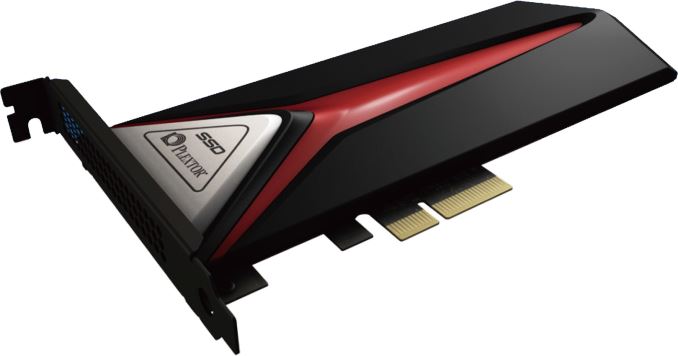Plextor to Demonstrate M8Pe Flagship SSD, EX1 USB Type-C SSD at Computex
by Anton Shilov on May 28, 2016 4:40 PM EST- Posted in
- Computex_2016
- SSDs
- PCIe SSD
- Trade Shows
- Plextor
- USB-C

Plextor plans to showcase its new SSDs next week at Computex 2016 trade show in Taipei, Taiwan. The new M8Pe will be the company’s new flagship storage solution and also the first high-end drive from the company in two years. Meanwhile, the EX1 will be Plextor’s first external solid-state storage device designed for those, who demand ultra-fast flash drives. In addition, the firm will demonstrate its next-generation mainstream M8Se SSD at the trade-show.
The Plextor brand got famous back in the 1990s, when the company introduced its first optical disc drives, which eventually were recognized as one of the finest quality ODDs in the industry. Eventually, the company experimented with other products as well, but its ODDs based on precision electric motors from Shinano Kenshi (the owner of the trademark) were still the best known devices featuring the name. Fast forward to 2010, Lite-On Technology licensed the Plextor brand, hired a team of engineers and teamed up with Marvell and Toshiba to develop SSDs, which would match the legendary name with performance and quality. Over the following years, Plextor/Lite-On released a number of SSDs that became popular among enthusiasts, which is why every new product by the company gets a great deal of attention. The years 2014 and 2015 were not exactly good for Plextor, though: the company ran into problems with its M6 Pro and then had to cancel the M7e. As a result, Plextor’s high-end lineup has not been updated for two years now, a very long time for the rapidly developing solid-state storage industry. However, the new flagship from the popular brand appears to be just around the corner and on paper it looks quite good.
The Plextor M8Pe family of SSDs will be based on Marvell’s 88SS1093 controller as well as Toshiba’s MLC NAND flash memory made using 15 nm manufacturing technology. The 88SS1093 features three cores and supports Marvell’s third-generation NANDEdge error correction control and management technology, which is based on LDPC (low-density parity-check code) and is designed to improve reliability of planar MLC and TLC NAND flash memory made using 15 nm fabrication process. Besides this, the controller fully supports NVMe protocol as well as new power management technologies.
The M8Pe drives will be available in 128 GB, 256 GB, 512 GB and 1 TB configurations. Plextor is specing the M8Pe 1 TB at up to 2500 MB/s for sequential reads and up to 1400 MB/s for sequential writes, but more affordable models will feature considerably lower speeds. The highest-capacity M8Pe can also perform up to 280K random read IOPS as well as up to 240K random write IOPS. Plextor’s numbers look rather competitive against Samsung’s 950 PRO, but we will need to test the novelty first before drawing any conclusions here.
| Specifications of Plextor M8Pe SSDs | |||||||||
| 128 GB | 256 GB | 512 GB | 1 TB | ||||||
| Model | PX-128M8PeY PX-128M8PeG |
PX-256M8PeY PX-256M8PeG |
PX-512M8PeY PX-512M8PeG |
PX-1TM8PeY PX-1TM8PeG |
|||||
| Form Factor | PCIe HHHL M.2-2280 |
PCIe HHHL M.2-2280 |
PCIe HHHL M.2-2280 |
PCIe HHHL M.2-2280 |
|||||
| Controller | Marvell 88SS1093 | ||||||||
| Interface | PCIe 3.0 x4 | ||||||||
| Protocol | NVMe 1.2 | ||||||||
| DRAM | 512 MB | 1 GB | |||||||
| NAND | Toshiba's MLC NAND made usin 15 nm process technology | ||||||||
| Sequential Read | 1600 MB/s | 2000 MB/s | 2300 MB/s | 2500 MB/s | |||||
| Sequential Write | 500 MB/s | 900 MB/s | 1300 MB/s | 1400 MB/s | |||||
| 4KB Random Read (QD32) | 120K IOPS | 210K IOPS | 260K IOPS | 280K IOPS | |||||
| 4KB Random Write (QD32) | 130K IOPS | 230K IOPS | 250K IOPS | 240K IOPS | |||||
| MTBF | 2.4 million hours | ||||||||
| Launch Date | June 2016 | ||||||||
As for form-factors, expect the new M8Pe flagship drives from Plextor to be available in both add-in PCIe 3.0 x4 card as well as M.2-2280 versions. It is noteworthy that the rated performance of the M8Pe drives in different form-factors is equal. The SSDs will feature heatsinks to prevent overheating of components as well as illuminating LEDs to complement modern high-end motherboards and PC chassis.
In addition to the flagship M8Pe, the Plextor will also demonstrate its forthcoming mainstream product, the M8Se. This SSD will come in an M.2 form-factor and will feature PCIe interface. At this time we have no information about the controller or NAND used by the M8Se.
Finally, the Plextor EX1 will be the brand’s first external fixed storage solution in a decade. The EX1 will be offered in 128 GB, 256 GB or 512 GB capacities. The maximum transfer rate of the drive will be 500 MB/s, which means that we are talking about an SSD and not just another USB flash stick. As for the interface, the EX1 will rely on USB Type-C (USB 3.1 Gen 1, 5 Gbps) and will thus be compatible with the latest PCs. While a fast external SSD from Plextor seems to be an interesting product, it remains to be seen which of Plextor’s exclusive technologies it will support, given the size and other constraints. Earlier this year we reviewed the Samsung T3 external USB-C SSD and it left a very positive impression. Plextor’s EX1 will offer some competition to Samsung’s external SSD.
The M8Pe SSDs from Plextor are expected to hit the market already in June. Pricing information has yet to be disclosed, but we do know that the drives will be backed by a five-year warranty. Further details regarding the M8Se and EX1 SSDs are unknown, but we'll publish that information once its available.
Source: Plextor












29 Comments
View All Comments
Magichands8 - Saturday, May 28, 2016 - link
I too just don't understand the obsession with M.2. I guess it's interesting for certain mobile applications but for a desktop I just don't get the point.ViRGE - Saturday, May 28, 2016 - link
1) Compared to inserting a small card, running cables sucks. (Especially U.2)2) The M.2 form factor offers enough bandwidth and capacity for most consumer uses.
LordanSS - Saturday, May 28, 2016 - link
I suppose you're right at the "peak bandwidth" on the desktop, but time and again M.2 solutions have proven to suffer from serious thermal throttling.And to fix that, you'd need to install heatsinks, which would negate most of the advantages of the small and thin form factor. Or reduce substantially performance, which would also negate the benefits of M.2.
Hence, in the end, I truly believe U.2 would be a better fit on computers, desktops specially.
ViRGE - Saturday, May 28, 2016 - link
"I suppose you're right at the "peak bandwidth" on the desktop, but time and again M.2 solutions have proven to suffer from serious thermal throttling."True, but that's if you slam it with a massive amount of writes. Even workstation loads aren't normally write-heavy enough to make throttling a real issue. And if it is, then you can go U.2.
zodiacfml - Sunday, May 29, 2016 - link
I don't know with your obsession with throttling. The latest drives are so fast that no client device will throttle such drives. It is only during testing and review that it will throttle.M.2 is forward looking, the interface has good physical dimensions for devices of today and probably within a decade but will eventually become too big as 2.5 inch drive form format is too big for SSDs.
joex4444 - Sunday, May 29, 2016 - link
The possibility of a desktop with no data cables is pretty neat from a cable management perspective. I've used RAID cards with SFF-8088 on them to break out into an 8 bay tower separate from the desktop and run all the storage from that leaving no drives inside the desktop itself.saratoga4 - Saturday, May 28, 2016 - link
Not much point in having mobile and desktop SSDs use incompatible formats. It's cheaper if the same parts can be used for both.Chaitanya - Saturday, May 28, 2016 - link
Only Samsungs 950 Pro thermally throttles under heavy loads. Rest of the M.2 drives work just fine in that form factor. So just stop bitching about thermal throttling of M.2 drives, and stop proving exception to be the rule. Also plextor is smart in providing some sort of heatsink for m.2 drive.Impulses - Monday, May 30, 2016 - link
Even the 950's throttling isn't a serious issue... But I still have my reservations about M.2 as a serious enthusiast/desktop interface in the long run. I think it's fine now, hell I've been running an SM951... What about when we want multiple M.2 drives tho? What about people that want multiple M.2 drives AND GPUs? Mobo design will get needlessly complex just to avoid a cable.M.2/U.2 could easily coexist as far as I can tell, so it's curious that only Intel has put much weight behind U.2.
Chaitanya - Saturday, May 28, 2016 - link
Only Samsungs 950 Pro thermally throttles under heavy loads. Rest of the M.2 drives work just fine in that form factor. So just stop bitching about thermal throttling of M.2 drives, so just stop proving exception to be the rule. Also plextor is smart in providing some sort of heatsink for m.2 drive.